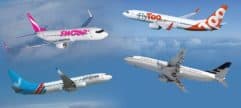
Global Low Cost Airlines Market by Product Type (Domestic, and International), By Application (Leisure Travel, Business Travel, and Others), and by Region and Country – Global Forecast to 2030
-
17337
-
April 2023
-
182
-
-
This report was compiled by Research Team Research team of over 50 passionate professionals leverages advanced research methodologies and analytical expertise to deliver insightful, data-driven market intelligence that empowers businesses across diverse industries to make strategic, well-informed Correspondence Research Team Linkedin | Detailed Market research Methodology Our methodology involves a mix of primary research, including interviews with leading mental health experts, and secondary research from reputable medical journals and databases. View Detailed Methodology Page
-
Marketresearch.Biz announces publication of its most recently generated research report titled, “Global Low Cost Airlines Market by Product Type (Domestic, and International), By Application (Leisure Travel, Business Travel, and Others), and by Region and Country – Global Forecast to 2030”, which offers a holistic view of the global low cost airlines market through systematic segmentation that covers every aspect of the target market. The global low cost airlines market is projected to be US$ 231,724.5 Mn in 2020 to reach US$ 458,728.6 Mn by 2028 at a CAGR of 8.8%.
Low cost airlines offer travel service tickets at a reasonable price compared to full service or traditional airlines. These airlines are also known as frills airlines, prizefighters, budget airlines, discount airlines, and low cost carriers (LCC). The American domestic carrier Southwest introduced the concept of low cost airlines with the sole objective of providing discounted airfares to consumers during late 1970s. Low cost airlines' operation remains the same: to deliver the lowest price to the customers by undercutting price levels of flagship carriers.
Its low cost model recognizes the operational feasibility of low cost airlines. The low cost model is a ‘modified’ version of the Southwest low cost model of operation. The model includes a low cost leadership position strategy. The goal of this strategy is to create a sustainable cost advantage over the competition. Several airlines are competing with each other, resulting in airline companies modifying their approach to stand out in the competition. The strategy is called a differentiation strategy, in which a company offers differentiated products that the customer values, thus increasing the company's market share. In mature markets such as the U.S., differentiation strategy is highly evident. The operators have struck a balance between the service model and low cost model to derive maximum margins.
Global Low Cost Airlines Market Revenue (US$ Mn), 2020–2030

Global low cost airlines market is segmented based on product type, application, and region/country. Based on product type, the market is segmented into domestic and international. The international segment is expected to register the highest CAGR, followed by the domestic segment іn thе glоbаl low cost airlines market. Based on the application, the market is segmented into leisure travel, business travel, and others. The leisure travel segment in the global low cost airlines market is estimated to account for a majority revenue share in 2020 end.
Global Low Cost Airlines Market Attractiveness Analysis by Product Type, 2014–2030
Rising government focus on infrastructure development and increasing liberalization is resulting in the rise of operational efficiency and increased investments in low cost airlines, is anticipated to drive the growth of the low cost airline market
Growth in the external trade globally is resulting in increased demand for cargo services. Thus, it is expected that there will be a rise in demand for low cost airlines for cargo services, which is also one of the factors estimated to bolster the global low cost airlines market
Massive investment in airlines, coupled with low profitability, is a challenge for vendors operating in this market. Major companies have reduced their flight charges to acquire a large customer base. However, these companies incur low margins, making it difficult to sustain in the market for a longer-term.
Segmentation of the Global Low Cost Airlines Market:
Segmentation by Product:
- Domestic
- International
Segmentation by Application:
- Leisure Travel
- Business Travel and Others
Segmentation by Regions:
- North America
- Europe
- APAC
- South America
- MEA
Attribute Report Details Market Size Ask For Market Size Growth Rate Ask For Growth Rate Key Companies Ask For Companies Report Coverage Revenue analysis, Competitive landscape, Key company analysis, Market Trends, Key segments, Distribution Channel, Market Dynamics, COVID-19 Impact Analysis and more… Historical Data Period 2015-2020 Base Year 2022 Forecast Period 2022-2031 Region Scope North America, Europe, Asia-Pacific, South America, Middle East & Africa Country Scope United States, Canada and Mexico, Germany, France, UK, Russia and Italy, China, Japan, Korea, India and Southeast Asia, Brazil, Argentina, Colombia etc.Saudi Arabia, UAE, Egypt, Nigeria and South Africa Revenue in US$ Mn -
- Chapter 1 Global Low Cost Airline Market Overview
- 1.1 Introduction
- 1.2 Drivers for Low Cost Airlines Market
- 1.3 Restraints for Low Cost Airline Market
- Chapter 2 Global Low Cost Airlines Market Insights
- 2.1 PEST Analysis
- 2.2 Porter’s Five Forces Analysis
- 2.3 Macro-Economic Factors
- 2.4 Market Investment Feasibility Analysis
- 2.5 Opportunity Orbits
- 2.6 Opportunity Map Analysis
- 2.7 Comparison between Full Service Carrier and Low Cost Carrier
- 2.8 Low Cost Airlines Key Players Head office and Area Served
- 2.9 Acquisition
- Chapter 3 Global Low Cost Airlines Market by Product Type
- 3.1.1 Global Low Cost Airlines Revenue (US$ Mn) Comparison by Product Type (2012-2028)
- 3.1.2 Global Low Cost Airlines Revenue (US$ Mn) Market Share by Product Type in 2018
- 3.1.3 Global Low Cost Airlines Market Attractiveness Analysis by Product Type, 2012–2018
- 3.2 Global Low Cost Airlines Market by Application
- 3.2.1 Global Low Cost Airlines Revenue (US$ Mn) Comparison by Application (2012-2028)
- 3.2.2 Global Low Cost Airlines Revenue (US$ Mn) Market Share by Application in 2018
- 3.2.3 Global Low Cost Airlines Market Attractiveness Analysis by Application, 2012–2018
- 3.3 Global Low Cost Airlines Market Outlook by Region
- 3.3.1 Global Low Cost Airlines Revenue (US$ Mn) Comparison by Region (2012-2028)
- 3.3.2 Global Low Cost Airlines Revenue (US$ Mn) Market Share by Region in 2018
- 3.3.3 Global Low Cost Airlines Market Attractiveness Analysis by Region, 2012–2018
- 3.4 Global Low Cost Airlines Market Outlook (2012-2028)
- 3.4.1 Global Low Cost Airlines Revenue (US$ Mn) (2012-2019)
- 3.4.2 Global Low Cost Airlines Revenue (US$ Mn) (2020-2028)
- Chapter 4 Global Low Cost Airlines Revenue (US$ Mn) by Regions
- 4.1 Global Low Cost Airlines Revenue (US$ Mn) Comparison by Region (2012-2019)
- 4.2 Global Low Cost Airlines Revenue (US$ Mn) Comparison by Region (2020-2028)
- Chapter 5 Global Low Cost Airlines Revenue (US$ Mn) by Product Type
- 5.1 Global Low Cost Airlines Revenue (US$ Mn) Comparison by Product Type (2012-2019)
- 5.2 Global Low Cost Airlines Revenue (US$ Mn) Comparison by Product Type (2020-2028)
- Chapter 6 Global Low Cost Airlines Revenue (US$ Mn) by Application
- 6.1 Global Low Cost Airlines Revenue (US$ Mn) Comparison by Application (2012-2019)
- 6.2 Global Low Cost Airlines Revenue (US$ Mn) Comparison by Application (2020-2028)
- Chapter 7 Global Low Cost Airlines Y-o-Y Growth Rate Comparison 2013–2028
- 7.1 Global Low Cost Airlines Y-o-Y Growth Rate by Region
- 7.2 Global Low Cost Airlines Market Y-o-Y Growth Rate by Product Type
- 7.3 Global Low Cost Airlines Y-o-Y Growth Rate by Application
- Chapter 8 Global Low Cost Airlines Share Comparison 2013–2028
- 8.1 Global Low Cost Airlines Share by Region
- 8.2 Global Low Cost Airlines Market Share by Product Type
- 8.3 Global Low Cost Airlines Share by Application
- Chapter 9 Global Low Cost Airline Market Company Profiles
- 9.1 Competitive Dashboard
- 9.2 Market Competition Scenario Analysis
- 9.3 Company Profiles
- 9.3.1 AirAsia Group Berhad
- 9.3.1.1 Company Overview
- 9.3.1.2 Business Description
- 9.3.1.3 Product Portfolio
- 9.3.1.4 Key Financials
- 9.3.1.5 Key Developments
- 9.3.1.6 SWOT Analysis
- 9.3.2 Norwegian Air Shuttle ASA
- 9.3.2.1 Company Overview
- 9.3.2.2 Business Description
- 9.3.2.3 Product Portfolio
- 9.3.2.4 Key Financials
- 9.3.2.5 Key Developments
- 9.3.2.6 SWOT Analysis
- 9.3.3 easyJet plc
- 9.3.3.1 Company Overview
- 9.3.3.2 Business Description
- 9.3.3.3 Product Portfolio
- 9.3.3.4 Key Financials
- 9.3.3.5 Key Developments
- 9.3.3.6 SWOT Analysis
- 9.3.4 Ryanair Holdings plc
- 9.3.4.1 Company Overview
- 9.3.4.2 Business Description
- 9.3.4.3 Product Portfolio
- 9.3.4.4 Key Financials
- 9.3.4.5 Key Developments
- 9.3.4.6 SWOT Analysis
- 9.3.5 Alaska Airlines, Inc.
- 9.3.5.1 Company Overview
- 9.3.5.2 Business Description
- 9.3.5.6 SWOT Analysis
- 9.3.6 WestJet Airlines Ltd.
- 9.3.6.1 Company Overview
- 9.3.6.2 Business Description
- 9.3.6.3 Product Portfolio
- 9.3.6.4 Key Financials
- 9.3.6.5 Key Developments
- 9.3.6.6 SWOT Analysis
- 9.3.7 Qantas Airways Limited
- 9.3.7.1 Company Overview
- 9.3.7.2 Business Description
- 9.3.7.3 Product Portfolio
- 9.3.7.4 Key Financials
- 9.3.7.5 Key Developments
- 9.3.7.6 SWOT Analysis
- 9.3.8 International Consolidated Airlines Group, S.A.
- 9.3.8.1 Company Overview
- 9.3.8.2 Business Description
- 9.3.8.3 Product Portfolio
- 9.3.8.4 Key Financials
- 9.3.8.5 Key Developments
- 9.3.8.6 SWOT Analysis
- 9.3.9 Go Airlines (India) Ltd.
- 9.3.9.1 Company Overview
- 9.3.9.2 Business Description
- 9.3.9.3 Product Portfolio
- 9.3.9.4 Key Developments
- 9.3.10 GOL Linhas Aéreas Inteligentes S.A.
- 9.3.10.1 Company Overview
- 9.3.10.2 Business Description
- 9.3.10.3 Product Portfolio
- 9.3.10.4 Key Developments
- 9.3.10.5 SWOT Analysis
- 9.3.11 SpiceJet Limited
- 9.3.11.1 Company Overview
- 9.3.11.2 Business Description
- 9.3.11.3 Product Portfolio
- 9.3.11.4 Key Financials
- 9.3.11.5 Key Developments
- 9.3.11.6 SWOT Analysis
- 9.3.12 Dubai Aviation Corporation
- 9.3.12.1 Company Overview
- 9.3.12.2 Business Description
- 9.3.12.3 Product Portfolio
- 9.3.13 JetBlue Airways Corporation
- 9.3.13.1 Company Overview
- 9.3.13.2 Business Description
- 9.3.13.3 Product Portfolio
- 9.3.13.4 Key Financials
- 9.3.13.5 Key Developments
- 9.3.13.6 SWOT Analysis
- 9.3.14 Air Arabia PJSC
- 9.3.14.1 Company Overview
- 9.3.14.2 Business Description
- 9.3.14.3 Product Portfolio
- 9.3.14.4 Key Financials
- 9.3.14.5 Key Developments
- 9.3.14.6 SWOT Analysis
- 9.3.15 Southwest Airlines Co.
- 9.3.15.1 Company Overview
- 9.3.15.2 Business Description
- 9.3.15.3 Product Portfolio
- 9.3.15.4 Key Financials
- 9.3.15.5 Key Developments
- 9.3.15.6 SWOT Analysis
- 9.3.1 AirAsia Group Berhad
- Chapter 10 Conclusion
- 10.1 Conclusion
- Chapter 11 Methodology and Data Source
- 11.1 Methodology/Research Approach
- 11.1.1 Market Size Estimation
- 11.2 Market Breakdown and Data Triangulation
- 11.3 Data Source
- 11.3.1 Secondary Sources
- 11.3.2 Primary Sources
- 11.4 Disclaimer
- 11.1 Methodology/Research Approach
- Chapter 1 Global Low Cost Airline Market Overview
-
- AirAsia Group Berhad
- Norwegian Air Shuttle ASA
- easyJet plc
- Ryanair Holdings plc
- Alaska Airlines Inc.
- WestJet Airlines Ltd.
- Qantas Airways Limited
- International Consolidated Airlines Group S.A.
- Go Airlines (India) Ltd.
- GOL Linhas Aéreas Inteligentes S.A.
- SpiceJet Limited
- Dubai Aviation Corporation
- JetBlue Airways Corporation
- Air Arabia PJSC
- Southwest Airlines Co.




